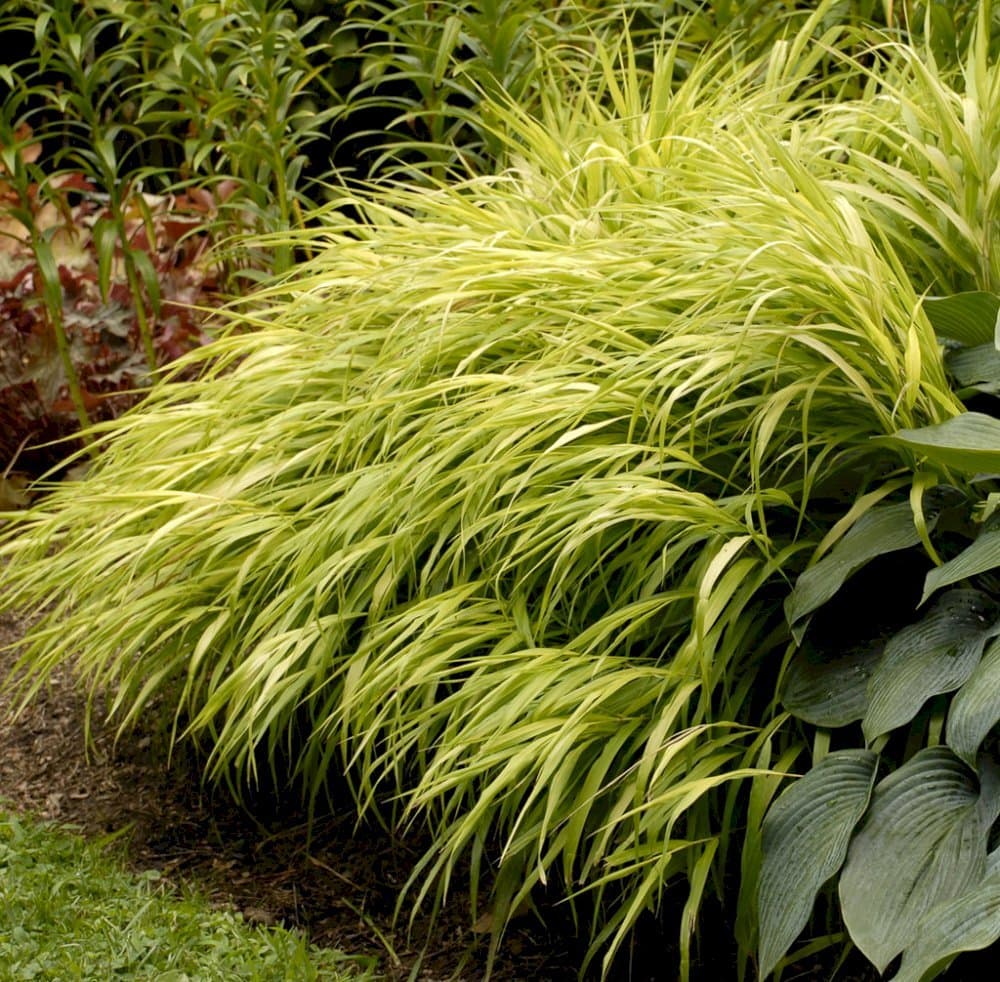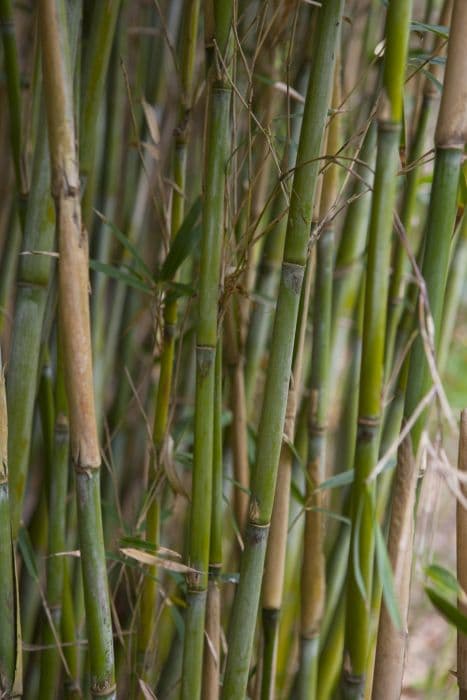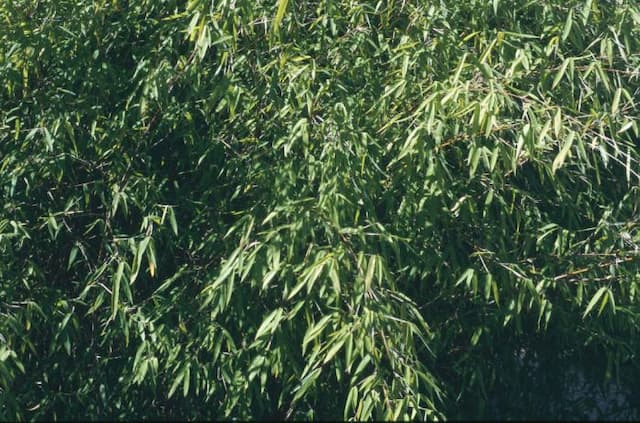Japanese Forest Grass Hakonechloa macra 'All Gold'

ABOUT
The Hakonechloa macra 'All Gold', commonly known as Japanese Forest Grass or Hakone Grass, is an ornamental grass renowned for its vibrant foliage. This cultivar stands out with its striking golden-yellow leaves that cascade gracefully, much like a golden waterfall or a fountain of bright foliage. The leaves are slender and arching, creating a soft, fine-textured appearance that shimmers in the light and can add a touch of luminosity to shaded areas. Throughout the seasons, the color intensity of Japanese Forest Grass 'All Gold' can vary, displaying the brightest tones in partial sun where it glows warmly. In deeper shade, the gold may present with slightly more muted undertones, yet it maintains its appealing hue. The leaves may also take on hints of chartreuse, adding depth and variation to the display. In the warmer months, delicate flower spikes may emerge, adding to the plant’s visual interest, but they are often considered secondary to the striking foliage. The graceful habit of this grass and the texture-rich leaves make it a popular choice for adding contrast and color in landscape design, container gardens, and as an accent plant in shaded gardens.
About this plant
 Names
NamesFamily
Poaceae
Synonyms
Japanese Forest Grass, Hakone Grass, Golden Hakone Grass
Common names
Hakonechloa macra 'All Gold'.
 Toxicity
ToxicityTo humans
Hakone grass is not known to be toxic to humans. Ingesting any part of the plant is unlikely to cause poisoning or adverse health effects.
To pets
Hakone grass is also not known to be toxic to pets. It is generally considered safe, and ingesting parts of this plant is unlikely to result in poisoning or negative health consequences for animals such as dogs and cats.
 Characteristics
CharacteristicsLife cycle
Perennials
Foliage type
Deciduous
Color of leaves
Gold
Height
1-2 feet (30-60 cm)
Spread
2 feet (60 cm)
Plant type
Grass
Hardiness zones
5
Native area
Japan
Benefits
 General Benefits
General Benefits- Visual Appeal: The Hakonechloa macra 'All Gold', commonly known as Japanese Forest Grass, is valued for its vibrant golden-yellow foliage which adds striking color contrast in garden settings.
- Low Maintenance: It is a relatively low-maintenance plant that does not require frequent pruning or pest control measures.
- Shade Tolerance: This plant is well-suited for shaded areas where other plants might struggle to thrive, making it ideal for woodland gardens or shady borders.
- Soil Erosion Control: Its dense growth habit helps stabilize soil and prevent erosion on slopes or in areas where grass might be difficult to grow.
- Seasonal Interest: Japanese Forest Grass adds year-round interest due to seasonal changes in foliage color and texture, with leaves that take on pink or red hues in autumn.
- Soft Texture: The soft, arching leaves of the plant provide a gentle texture that can soften the landscape and add a sense of movement with the wind.
- Compatibility: It is compatible with a variety of other shade-loving plants and can be used as a ground cover or as a complement to other perennials and shrubs.
- Hardiness: It is resilient in a range of hardiness zones, typically from 5 to 9, allowing it to be grown in various climates.
- Wildlife Attraction: While not specifically grown for wildlife, its dense foliage can provide shelter for small creatures and insects.
 Medical Properties
Medical PropertiesThis plant is not used for medical purposes.
 Air-purifying Qualities
Air-purifying QualitiesThis plant is not specifically known for air purifying qualities.
 Other Uses
Other Uses- Hakone Grass can be implemented into a sensory garden due to its soft, fine texture that offers a unique tactile experience.
- As part of a natural dye garden, the golden leaves of Hakone Grass can be used to extract subtle coloring agents for fabrics and yarns.
- Artisans may use the long, flowing leaves of Hakone Grass in weaving projects like baskets, mats, or decorative panels.
- In Japanese gardens, Hakone Grass is often utilized to craft picturesque landscape scenes that change with the seasons.
- When dried, the blades of Hakone Grass can be included in floral arrangements and wreaths for a touch of natural golden color.
- Hakone Grass can act as a visual cue in garden design, signaling changes in terrain or to mark the edges of different garden rooms.
- This grass can be used in container gardens to provide a cascading, fountain-like effect that contrasts well with more rigid plants.
- Photographers often use Hakone Grass as a soft-focus foreground element in garden photography to add depth and interest.
- Educators may include Hakone Grass in lessons about ornamental horticulture and plant cultivation techniques.
- The plant's movement in the breeze can serve as a natural wind indicator in a calming garden setting.
Interesting Facts
 Feng Shui
Feng ShuiThe Hakone grass is not used in Feng Shui practice.
 Zodiac Sign Compitability
Zodiac Sign CompitabilityThe Hakone grass is not used in astrology practice.
 Plant Symbolism
Plant Symbolism- Golden Beauty: The 'All Gold' variety of Japanese forest grass symbolizes radiant beauty and grace, as its bright golden foliage adds a striking visual appeal to gardens.
- Adaptability: Japanese forest grass can thrive in various light conditions, symbolizing versatility and the ability to adapt to different situations in life.
- Tranquility: Often used in Japanese gardens, which are spaces designed for contemplation and relaxation, Japanese forest grass represents peace and tranquility.
 Water
WaterJapanese Forest Grass prefers consistently moist soil, so it should be watered regularly, especially during the growing season. The aim is to keep the soil evenly moist, but not waterlogged. It typically requires about 1 inch of water per week, either from rainfall or manual watering. During hot, dry spells, it may need additional water, but always check the soil moisture to avoid overwatering. Over the winter, when the plant is dormant, watering can be reduced considerably.
 Light
LightJapanese Forest Grass thrives in partial shade but can tolerate a few hours of morning sunlight. It is best situated in a spot that receives dappled sunlight throughout the day, avoiding the intense afternoon sun which can scorch its delicate leaves. The ideal location would provide bright but indirect light, which promotes the vibrant golden color of its foliage.
 Temperature
TemperatureJapanese Forest Grass is hardy and can tolerate a range of temperatures, but it does best in areas where the temperature stays between 40°F and 85°F. It can survive in temperatures as low as 20°F and as high as 90°F, but outside of its comfort range, the plant may experience stress or damage. The ideal growing conditions include moderate temperatures with high humidity.
 Pruning
PruningPruning Japanese Forest Grass isn’t strictly necessary but can help maintain its shape and encourage new growth. Pruning should be done in late winter or early spring before new growth begins. You can cut back the foliage to about 3 inches above the ground every few years, which refreshes the plant and helps prevent the center from dying out. The best time for pruning is just as the snow melts or as the ground is no longer frozen.
 Cleaning
CleaningAs needed
 Soil
SoilHakone Grass thrives in a soil mix with good drainage, slight acidity to neutral pH (5.5 to 7.0). A mixture of loam, compost, and pine bark or peat moss often works best, ensuring nutrients and moisture retention while preventing waterlogging.
 Repotting
RepottingHakone Grass, or Japanese Forest Grass, should be repotted every 2 to 3 years. It's best to do this in the spring when the plant begins to show new growth, to minimize stress and encourage quick establishment in the fresh soil.
 Humidity & Misting
Humidity & MistingJapanese Forest Grass prefers average to high humidity levels but is quite adaptable. Aim for 40-60% relative humidity for optimal growth; however, it can tolerate lower humidity levels without significant adverse effects.
 Suitable locations
Suitable locationsIndoor
Place in bright, indirect light and keep soil moist for indoor Hakone Grass.
Outdoor
Part shade, moist soil, protect from harsh sun for outdoor Hakone Grass.
Hardiness zone
5-9 USDA
 Life cycle
Life cycleHakone grass 'All Gold' begins its life as a seed, although it is more commonly propagated by division. Once germinated or established, it grows into a clump-forming perennial with striking golden-yellow foliage. During spring and summer, it reaches maturity and thrives, producing arching leaves and contributing to its mound-shaping habit. As an ornamental grass, it does not have a pronounced flowering stage, but it can produce inconspicuous flower spikes in late summer. In autumn, its leaves may take on shades of pink or red before the plant enters dormancy in winter. With the return of warmer temperatures in spring, Hakonechloa 'All Gold' breaks dormancy and begins a new growth cycle.
 Propogation
PropogationPropogation time
Spring-Early Summer
The Japanese Forest Grass 'All Gold' is typically propagated by division, which is best done in the spring just as the new growth begins to emerge. This is the most popular method of propagation for this ornamental grass. To propagate by division, carefully dig up the entire clump of the grass and gently separate it into smaller sections, each with roots and shoots. Replant these divisions at the same depth they were growing previously, spaced about 12 to 18 inches apart to give them room to grow. Water the new divisions well to help establish them. It's important to keep the soil consistently moist but not waterlogged during the first growing season to ensure a successful establishment.









